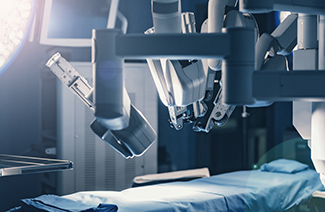Approximately 1 in 9 men will experience prostate disease in their lifetime. And as men age the probability increases – for men in their 60s it is 50% and for those 70+ it is 90%.
Most prostate enlargement is benign and can be monitored with through check-ups. But if a problem were to occur, one option for treatment is to remove the prostate through a prostatectomy.
A traditional prostatectomy can involve major surgery, but a robotic-assisted laparoscopic prostatectomy can reduce risk and increase accuracy.
“It’s a game-changer,” says urologic surgeon Robert Carey, MD, PhD, FACS, one the surgeons leading the First Physicians Group Prostate Clinic. “This revolutionizes the way we do prostate surgery.”
What is “Robotic-assisted Laparoscopic Prostatectomy”?
A robotic prostatectomy is a minimally invasive procedure to remove part or all of the prostate using an advanced surgical system that improves precision and hastens recovery.
Robotic surgery utilizes small “keyhole incisions,” through which tiny robotic instruments can enter the abdomen. Under the control of the surgeon, these instruments can perform with better range of motion and greater precision. Advanced imaging equipment provides a magnified 3D image of the prostate and the surrounding tissue, allowing the surgical team to operate efficiently and effectively, while preserving healthy tissue and nerves.
What Are The Benefits Of Robotic Prostate Surgery?
“Robotic surgery has a number of advantages,” says Dr. Carey. In comparison to traditional surgery which has a much larger abdominal incision, the benefits of a minimally invasive robotic prostatectomy are significant.
These include:
- Reduced risk of infection or complication
- Less blood loss
- Faster surgery time
- Shorter hospital stay
- Less pain
- Quicker recovery
- Smaller scar
And these advantages bring secondary benefits too, notes Dr. Carey.
With quicker recoveries and less pain, there’s no need to prescribe strong pain medications or narcotics. “The majority of men who undergo a robotic prostatectomy will take an anti-inflammatory medication like Tylenol,” he says. “They won’t typically have severe pain.”
Does Robotic Surgery Have Risks or Side Effects?
All surgery has a certain amount of risk including bleeding, complications and potential damage to the surrounding tissue. But with the minimally invasive approach that robotic surgery allows, and the precision with which it can be performed, these risks are much lower.
The two primary potential side effects of a successful robotic prostatectomy are the same as with a successful traditional prostatectomy: urinary incontinence and erectile dysfunction.
- Urinary incontinence, or the inability to control the release of urine, is a side effect that often improves with time. Muscle strengthening exercises can be employed to great success, if the problem persists.
- Erectile dysfunction can also be a temporary side effect. But in general, nerve-sparing techniques with robotic surgery can preserve sexual function and performance, though it is partially dependent on patient age and degree of sexual function before surgery.
Follow Up With A Doctor
If you, or someone you know, are experiencing signs of an enlarged prostate, such as difficulty urinating, frequent urination or urinary incontinence, contact the specialists at the First Physicians Group Prostate Clinic.

Robert Carey, MD, PhD, FACS is a board certified Urologist and Robotic Surgeon with First Physicians Group. For more information or to make an appointment, please call (941) 917-5400.


